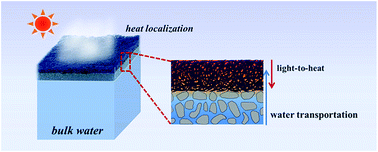Hydrophobic W18O49 mesocrystal on hydrophilic PTFE membrane as an efficient solar steam generation device under one sun†
Abstract
Solar steam generation is a promising application for utilizing exhaustless solar energy for steam generation, desalination, sterilization, and water treatment. Over the past several decades, scientists have made many attempts to design rational structures to promote evaporation efficiency including optimizing optical absorption, photothermal conversion, heat localization, and water transportation. Here, an efficient solar steam generation device was fabricated through decorating a nonstoichiometric W18O49 mesocrystal, as a solar light-to-heat material, onto a hydrophilic PTFE membrane. Nonstoichiometric W18O49 mesocrystals were incorporated into the membrane, and confirmed by the XRD, SEM, TEM, and XPS characterizations, which can transfer light to heat after absorbing sunlight and lead to water evaporation on a local area of a membrane. The structure of the solar steam generation device was confirmed by the results of SEM and contact angle measurements, which insured the solar steam generation device self-floated on top of water, thereby providing a continuous water supply to the local area heated by the W18O49 mesocrystals from bulk water. Under one sun illumination, the evaporated water mass loss reached 1.13 kg m−2 for a membrane thickness of M/A = 9.83 g m−2 after 1 h irradiation, and the membrane showed a high efficiency of 80.7%. Limit of water evaporation rate for the W18O49@PDMS mesocrystal membrane was further calculated to be 1.15 kg m−2 after 1 h one-sun irradiation, with a limit of efficiency of 82.0%. The salinities of simulated seawater reduced to levels far below the World Health Organization's (WHO) standard after desalination. The rational design enhancing evaporation performance also provides enlightenment for further practical applications of solar steam generation technology.



 Please wait while we load your content...
Please wait while we load your content...